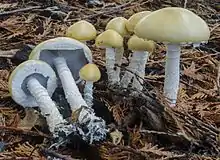Stropharia ambigua
Stropharia ambigua, sometimes known as the questionable Stropharia, is a saprotrophic agaric mushroom, commonly fruiting in leaf litter and wood chips in the western United States and Canada.
| Stropharia ambigua | |
|---|---|
 | |
| Scientific classification | |
| Kingdom: | |
| Division: | |
| Class: | |
| Order: | |
| Family: | |
| Genus: | |
| Species: | S. ambigua |
| Binomial name | |
| Stropharia ambigua | |
| Synonyms | |
|
Hypholoma ambiguum Peck (1898) | |
| Stropharia ambigua | |
|---|---|
float | |
| gills on hymenium | |
| cap is convex | |
| hymenium is adnate | |
| stipe has a ring | |
| spore print is purple-brown | |
| ecology is saprotrophic | |
| edibility: unknown | |
Description
The cap is 3 to 15 cm (1.2 to 5.9 in) broad, obtuse to convex, becomes flat or uplifted in age, has a smooth surface, is slimy when moist, and yellowish. The flesh is white, thick, and soft. The gills are pale gray and gradually darkens to purplish-gray or purplish-black.[1] The gills occasionally pull away from the stipe with age.[2] The stipe is 6 to 18 cm (2.4 to 7.1 in) long and is stuffed or hollow. The veil is soft and white. The spore print is dark purplish to nearly black. The species fruits in the spring and fall.[1] It does not have a volva.[2]
Edibility
The species has been said to taste like old leaves.[3] Because of conflicting reports that they received on the edibility of this species, the authors Orson K. Miller, Jr. and Hope Miller do not recommend eating it.[4] Alexander Hanchett Smith and Nancy S. Weber said that the species is not poisonous.[1] David Arora does not recommend eating this species.[2] The authors of Poisonous plants of California said that the species is suspected of being poisonous.[5]
Distribution and habitat
Stropharia ambigua appears in late fall as a solitary to scattered mushroom or in groups on rich humus, usually under conifers. It can also be found with alder and other hardwoods in the Pacific Coast.[3] It has frequently been found in disturbed areas, such as where wood was handled.[1] The species will colonize outdoor mushroom beds after wood chips have been decomposed by a primary saprotroph.[6] It favors a cold and damp environment.[2]
References
- Smith, Alexander Hanchett; Weber, Nancy S. (1980). The Mushroom Hunter's Field Guide. University of Michigan Press. p. 226. ISBN 978-0-472-85610-7.
- Arora, David (1991). All That the Rain Promises and More: A Hip Pocket Guide to Western Mushrooms. Ten Speed Press. p. 126. ISBN 978-0-89815-388-0.
- Arora, David (1986). Mushrooms Demystified: A Comprehensive Guide to the Fleshy Fungi. Ten Speed Press. p. 378. ISBN 978-0-89815-169-5.
- K. Miller, Orson; Miller, Hope (2006). North American Mushrooms: A Field Guide to Edible and Inedible Fungi. Globe Pequot. p. 256. ISBN 978-0-7627-3109-1.
- Multiple authors, Fuller Thomas C.; McClintock, Elizabeth May (1986). Poisonous Plants of California. University of California Press. p. 53. ISBN 978-0-520-05569-8.
- Stamets, Paul (2000). Growing gourmet and medicinal mushrooms. Ten Speed Press. p. 12. ISBN 978-1-58008-175-7.